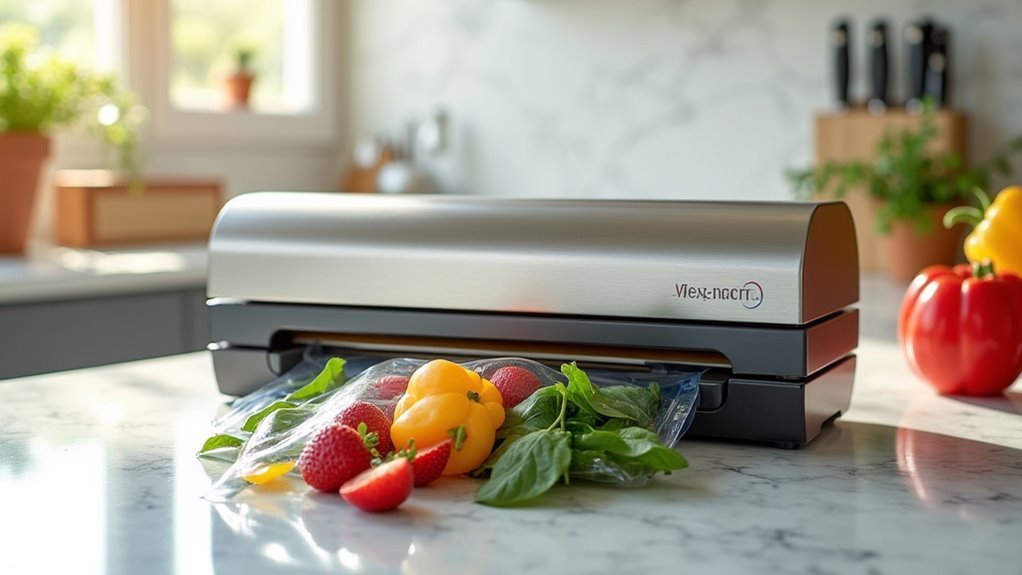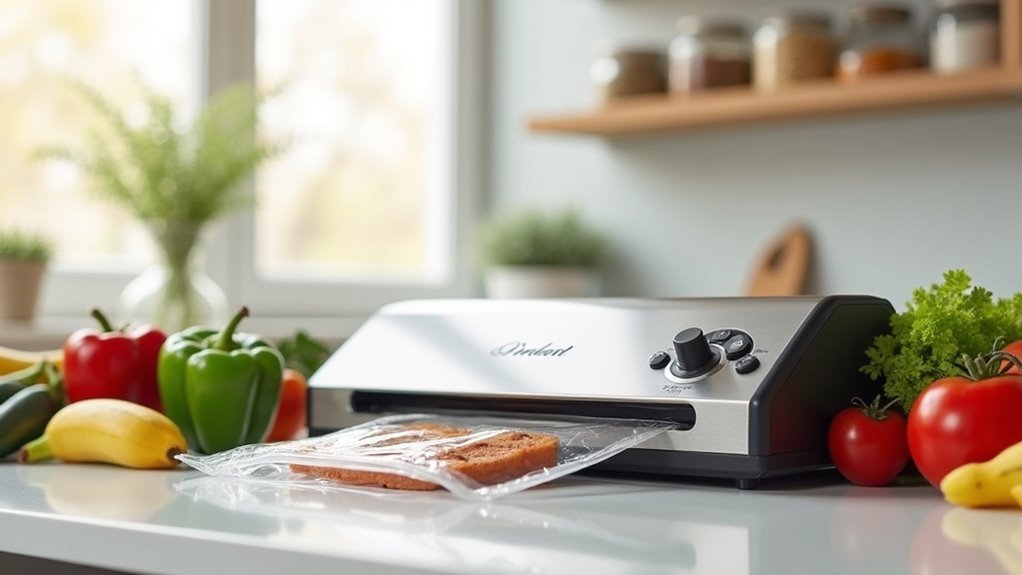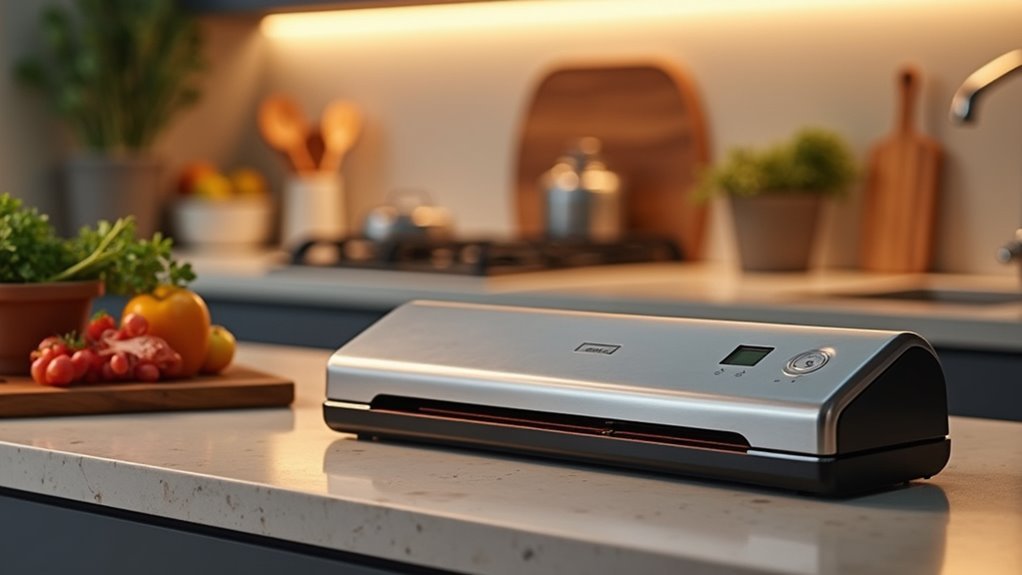We’ll break down vacuum sealers into five key components that make food preservation so effective. The vacuum chamber creates an airtight environment while removing air from pouches, preventing spills and contamination. A heated sealing bar with proper heat distribution melts bag edges for uniform, strong seals. Vacuum pumps, either rotary vane or piston types, provide the suction power needed. Digital control panels let you customize settings for different foods, while safety mechanisms like automatic shut-off and emergency stops protect against overheating. Understanding these components will help you maximize your machine’s potential and achieve professional results.
Vacuum Chamber Design and Functionality

When we’re exploring vacuum sealers, the vacuum chamber stands as the heart of the entire operation – it’s where all the magic happens!
This sealed environment creates the perfect vacuum conditions while preventing air from sneaking back in during the sealing process.
What makes it brilliant is the heated sealing strip at the bottom that creates an airtight seal by warming the packaging material’s edges.
We love how the top-opening design makes loading and removing pouches incredibly easy.
Chamber vacuum sealers work by removing air from both the pouch and chamber simultaneously, maintaining equal pressure that prevents messy liquid spills.
The chamber’s size determines how many pouches you can seal at once. Additionally, these machines are ideal for marinating meats, allowing flavors to penetrate deeply for enhanced taste.
Sealing Bar Components and Heat Distribution
The sealing bar serves as the powerhouse component that transforms your vacuum sealer from a simple air-removal device into a complete packaging system! This heating element creates that essential airtight seal by melting your bag’s edges together, trapping out every bit of air.
We can’t emphasize enough how important proper heat distribution is along the entire sealing bar. When heat spreads evenly, you’ll get those perfect, uniform seals every time. However, uneven heating creates weak spots that’ll compromise your seal’s integrity.
Most sealing bars reach peak temperatures quickly and maintain consistent heat throughout the sealing process. The stainless steel construction guarantees durability while conducting heat efficiently across the bar’s full length, giving you reliable performance seal after seal. Additionally, a strong vacuum power is crucial for achieving a tight seal on Mylar bags, ensuring optimal food preservation.
Vacuum Pump Types and Performance

While sealing bars get much of the attention, vacuum pumps truly drive the magic behind every successful vacuum sealing operation! These hardworking components determine how effectively your sealer removes air and creates those perfect airtight seals.
You’ll encounter two main vacuum pump types in today’s sealers. Rotary vane pumps power commercial-grade units, delivering lightning-fast air removal and rock-solid durability for high-volume tasks.
Meanwhile, piston pumps typically fuel consumer models, creating around 0.025 inHg vacuum pressure—perfect for everyday home sealing needs.
The key difference? Rotary vane pumps excel in professional kitchens where speed and consistency matter most, while piston pumps offer reliable performance for typical household use.
Regular maintenance keeps both types running smoothly, ensuring your vacuum pump continues delivering exceptional sealing results for years to come! Selecting the right vacuum sealer model, considering features like sealing modes for various food types, enhances your food preservation outcomes.
Control Panel Features and Settings
Smart technology transforms ordinary vacuum sealers into precision powerhouses through their intuitive control panels!
We’ll discover how these sophisticated interfaces put complete sealing control at your fingertips.
Modern control panels feature buttons, knobs, or touchscreens that let you customize vacuum strength and sealing time for perfect results every time. Digital displays show temperature, pressure, and operational status, so we can monitor everything happening during the process.
Many of today’s vacuum sealers, like the SEATAO VH5188, include preset programs for different food types that protect delicate foods while ensuring thorough air removal from heartier items.
Additionally, many units include preset programs for different food types, making operation simple even for beginners. Safety features like automatic shut-off prevent overheating, keeping us protected while we work.
These smart controls transform vacuum sealing from guesswork into precise food preservation!
Safety Mechanisms and Protection Systems

Multiple layers of protection work tirelessly behind the scenes to keep us safe while we’re vacuum sealing our favorite foods!
These safety features aren’t just nice-to-haves – they’re essential guardians that prevent accidents and equipment damage.
Here’s what’s protecting us during every sealing session:
- Automatic shut-off mechanisms that prevent overheating and fire hazards during extended use
- Emergency stop buttons giving us instant control when something goes wrong
- Pressure sensors and temperature controls that automatically adjust to protect internal components
- Safety indicators like lights and alarms that alert us when sealing’s complete or issues arise
We can’t forget that regular maintenance keeps these protective systems working properly. In addition, ensuring routine maintenance on the vacuum sealer supports these safety mechanisms to function optimally.
When safety mechanisms malfunction, they can’t do their job of keeping us safe during operation.
Frequently Asked Questions
What Is the Principle of Vacuum Sealer?
We’ll explain how vacuum sealers work through their sealing process: vacuum technology removes air from packaging, creating oxygen-free environments for superior food preservation by preventing bacterial growth and extending shelf life considerably.
What Should I Look for in a Vacuum Sealer?
When selecting a vacuum sealer, we’ll create a features checklist including adjustable pressure settings, reliable sealing mechanisms, and size capacity. Research best brands and read user reviews to find models that meet your specific food preservation needs.
How Does Vacuum Sealing Work?
They say an ounce of prevention’s worth a pound of cure – we’ll show you how vacuum sealing works among food preservation methods, delivering vacuum sealing benefits that make the best vacuum sealers essential kitchen investments.
What Is the Science Behind Vacuum Sealing?
We comprehend vacuum sealing benefits through oxygen elimination science. Air removal techniques create anaerobic environments that halt bacterial growth and oxidation. These food preservation methods work by stopping decomposition processes that require oxygen to function effectively.
